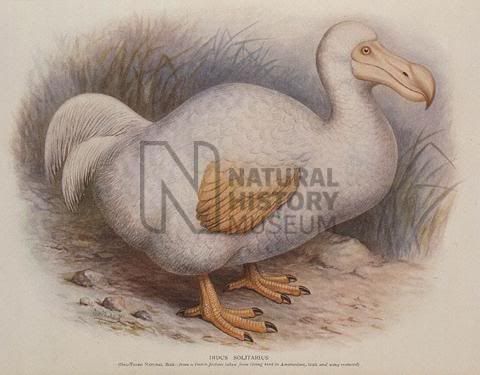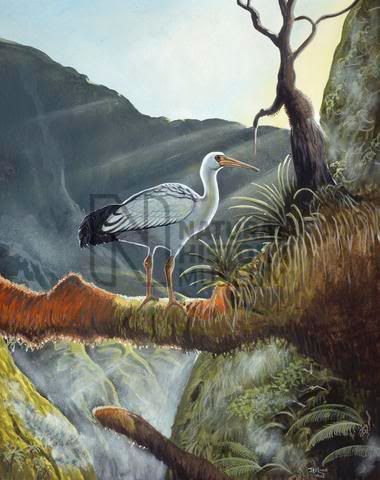|
|
Post by another specialist on Jun 6, 2005 6:29:24 GMT
Threskiornis solitarius
(Sélys-Longchamps) 1848
Late Holocene of Réunion, w Mascarene Islands, wc Indian Ocean
Primary materials:
Cécile Mourer-Chauviré, C. Roger Bour & Sonia Ribes,
Position systémathique du solitaire de la Réunion: Nouvelle interprétation basée sur les restes fossiles et les récits des anciens voyaguers
Comptes Rendus de l'Académie des Sciences sér. 2A, 320 (1995): 1125-1131
|
|
|
|
Post by another specialist on Jun 6, 2005 6:29:41 GMT
This taxon is better known under its old name Réunion Solitaire, Raphus solitarius (Sélys-Longchamps 1848), but the authors have made convincing case, on the basis of fossil finds, that it is not a member of the Raphidae, but rather of the Threskiornithidae.
|
|
|
|
Post by Melanie on Jun 7, 2005 16:15:54 GMT
formerly falsely described and painted as "White Dodo"  |
|
|
|
Post by Melanie on Jun 7, 2005 16:17:56 GMT
Here is a painting which is showing the new reconstruction  |
|
|
|
Post by another specialist on Jun 7, 2005 20:17:41 GMT
|
|
|
|
Post by another specialist on Jun 8, 2005 7:14:28 GMT
Family/Sub-family THRESKIORNITHIDAE Species name author (Mourer-Chauviré & Moutou, 1987) Taxonomic source(s) Sibley and Monroe (1990, 1993) Synonyms Raphus solitarius Sibley and Monroe (1990, 1993) Taxonomic note If the Réunion `solitaires' were indeed T. solitarius2, then both Victoriornis imperialis2 and Borbonibis latipes4 become synonyms. Summary Threskiornis solitarius is known from bones recently discovered on Réunion (to France)4. It seems likely that the `solitaire' known from numerous early accounts from Réunion1 was in fact this ibis3, vindicating arguments for independent evolution of the Mascarene `solitaires'5, in which case its extinction can be placed in the early 18th century with the last account being that of Feuilley in 17051. www.birdlife.net/datazone/search/species_search.html?action=SpcHTMDetails.asp&sid=30102&m=0 |
|
|
|
Post by sebbe67 on Oct 25, 2005 21:49:40 GMT
The Réunion Flightless Ibis (''Threskiornis solitarius'') is an extinct bird species that was native to the island of Réunion. It is probably the same bird discovered by Portuguese sailors there in 1613 and until recently assumed by biologists to be a member of the solitaire family, who called it the "'''Réunion Solitaire'''" (''Raphus solitarius'') and classified it as a relative of the Dodo. That bird was at various times classified as Victoriornis imperialis (the "Réunion Solitaire" or "White Dodo" of descriptions and paintings - the latter obviously show an albino dodo from Mauritius) and Borbonibis latipes (from the first Ibis bones found, before a connection to the solitaire reports had been made). The epithet solitarius derives from the Raphus solitarius description of Baron Edmund de Sélys-Longchamps in 1848, but the species' existence was not confirmed until the discovery of bones on Réunion in the late 20th century. The discovery that it actually was an Ibis perfectly fits what the early travellers said about its plumage and habits. The confusion can be explained by the fact that solitaire was used by the writers of the descriptions as a descriptive term regarding to a birds' solitary habits, which the Ibis happened to share with the Rodrigues Solitaire, but was interpreted by the scientists as an indication of a taxonomic relationship. The last account of the "Réunion Solitaire" was recorded in 1705, indicating that the species probably became extinct sometime early in that century. The vernacular name is misleading, since travellers' reports as well as bone measurements indicate that it was well on its way to flightlessness, but could still fly some distance after a running take-off. Category:Extinct birds
|
|
|
|
Post by another specialist on Oct 26, 2005 3:46:49 GMT
|
|
|
|
Post by another specialist on Oct 26, 2005 3:50:54 GMT
|
|
|
|
Post by Melanie on Nov 2, 2005 22:19:51 GMT
[ Le mensonge de l'ibis
Is this bird in the center the réunion-flightless-ibis (Threskiornis solitarius)?
Click here to see image
The translation of the book's page:
History of the endemic animals of Mascareignes. The film made to Reunion, Mauritius and Rodrigues explains how the animals arrived in Mascareignes after having crossed thousands of kilometers of ocean by their own means or carried by the marine winds and currents. Specificities of the animal species seen by the first navigators at the 17th century are then described and explained: endemisation, geographical speciation, convergence of the forms, gigantism, loss of the aptitude for the flight. The causes of the disappearance of a great part of this fauna are finally analyzed. Let us note that what had occurred as regards evolution from the species in Mascareignes had also passed in other volcanic islands like Galapagòs and which it is there that a certain Charles Darwin will conceive his theory of the evolution of the species and the natural selection...
The book page:
web.archive.org/web/20030519153251/http://www.crdp-reunion.net:80/catloc/fichekata/974V/974V0026.php3 |
|
|
|
Post by another specialist on Nov 2, 2005 23:03:54 GMT
I would say no - the illustration seems to show an ibis with the ability to fly (full sized wings not reduced which a flightless species would have)
|
|
|
|
Post by another specialist on Nov 4, 2005 6:18:47 GMT
Also the two other reconstructions seem to show the same. The second image shows the bird flapping its wings - the wings look fully functional to me...
|
|
|
|
Post by another specialist on Nov 4, 2005 6:20:41 GMT
|
|
|
|
Post by RSN on Nov 6, 2005 17:49:15 GMT
|
|
|
|
Post by another specialist on Nov 6, 2005 18:06:02 GMT
Thanks RSN was a pic i was going to upload myself
|
|
|
|
Post by sebbe67 on May 13, 2006 11:22:21 GMT
|
|
|
|
Post by Melanie on Jul 9, 2008 1:38:11 GMT
|
|
|
|
Post by Melanie on Jul 9, 2008 1:39:51 GMT
That bone is assigned today to Threskionis solitarius. |
|
|
|
Post by Melanie on Jul 9, 2008 1:40:23 GMT
If you can verify that with a source this thread should be merged with Threskionis solitarius. That bone is assigned today to Threskionis solitarius. |
|
|
|
Post by Melanie on Jul 9, 2008 1:41:05 GMT
I read before somewhere that the supposed stork was in fact the Réunion Ibis, but you can check this in Lost Land of the Dodo, page 103, Box 8. The expurgation of this supposed Ciconia is in the article by Graham S. Cowles -yes, the same guy who was sure the bone was from Ciconia- "A new genus, three new species and two new records of extinct holocene birds from Réunion Island, Indian Ocean". Geobios, 27 (1), p. 87-93. |
|